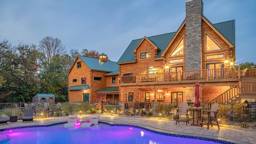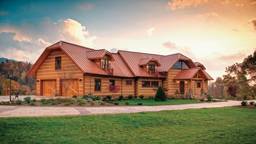
There’s plenty of joy at the prospect of making your dream log home a reality, but if you’re like most people planning a custom home, it’s likely you have some anxiety as well. You may worry about making a blunder—a mistake that could leave you with a home that’s (gasp!) less than perfect. That’s why we want to take some of the guesswork out for you. We’ve contacted new home owners to ask what they did right, what they did wrong and how they saved money along the way. Keep their lessons in mind when you’re designing your dream home and that little voice you keep hearing inside your head won’t be nagging doubt—it will be the voice of experience.
See also 9 Interface Log Options
1. Time is on Your Side
Situation:
One of the biggest mistakes people make when designing a custom home is not spending enough time on the actual design process.Solution:
“I have very few things I’d change about my home, but then I spent 15 years designing it,” says Clark Thompson, who built a 4,100-square-foot BK Cypress home in Waynesville, North Carolina. Though a decade-and-a-half is longer than most people want to spend when drafting their dream home, don’t rush the process. (Most home owners recommend you spend at least two years refining your design.) After making revisions to your plan, put it aside for a few days. When you come back to it with fresh eyes, imagine yourself walking through the layout, stopping at points of interest, relaxing in each room. You’ll know when it feels like home.
2. Clip & Keep
Situation:
Trying to convey in words exactly what you want can be tough, particularly if you’re not up on architectural terminology.Solution:
“I bought every magazine, plansbook and log home primer I could get my hands on,” says Tennessee resident Carol Cullum, who, with her husband Gary, built a 3,000-square-foot Hearthstone home in the Smoky Mountains. “We cut out pictures of kitchens, bedrooms, great rooms or products we liked, then organized them into folders.” You’ll be surprised at how this simple exercise can help you hone your wants and needs, then paint an accurate picture for your designer.
See also The Downsides of a Vaulted Ceiling
3. Make Way For the Every Day
Situation:
Bob and Susan Bowman say their new 4,000-square-foot handcrafted log home in Castle Pines, Colorado, is everything they dreamed of—except for providing a convenient space to use the computer. “I wish I designed a computer workstation right in the kitchen, or at least near it,” says Susan. “Our laptops and papers always end up on the dining room table. We have to move everything to entertain.”Solution:
Accounting for your home-wiring needs is essential—especially in a log home that could present some tough (and expensive) retrofitting challenges. Anticipate how you’ll live in the next 10+ years and design your home to accommodate those needs.
4. Every Square Foot Counts
Situation:
Sandra and Steven Selengut adore their 5,000-square-foot home set on the edge of a saltwater marsh on Johns Island in South Carolina. “But I think we could have built more house for our money if we’d made a few design changes,” says Sandra. “The design is octagonal, and I think if we’d squared it up a little, we’d have more closet and storage space.”Solution:
Adequate storage is one of the most frequently overlooked areas of home design. As you evaluate your plan, take a good, hard look at all the stuff you intend to store, and be sure your new log home can handle it. Add storage beneath stairs, in the basement, near the front and side doors, near bathrooms and in the laundry room. And don’t forget to reclaim “dead” space in the low areas around gables. This is the perfect place to store seasonal goodies.
5. Pump up the Porch
Situation:
“Our home has a porch on three sides, but I wish I’d put one on all four sides,” says Clark Thompson.Solution:
Covered porches are not only nostalgic and a fun place for friends and family to hang out, they’re functional, too. A deep overhang (6 feet should do the trick on most homes) will guard log walls from the damaging effects of rain and snowfall, resulting in less maintenance for you.
Read the full story in the December 2006 issue of Log Home Design.











